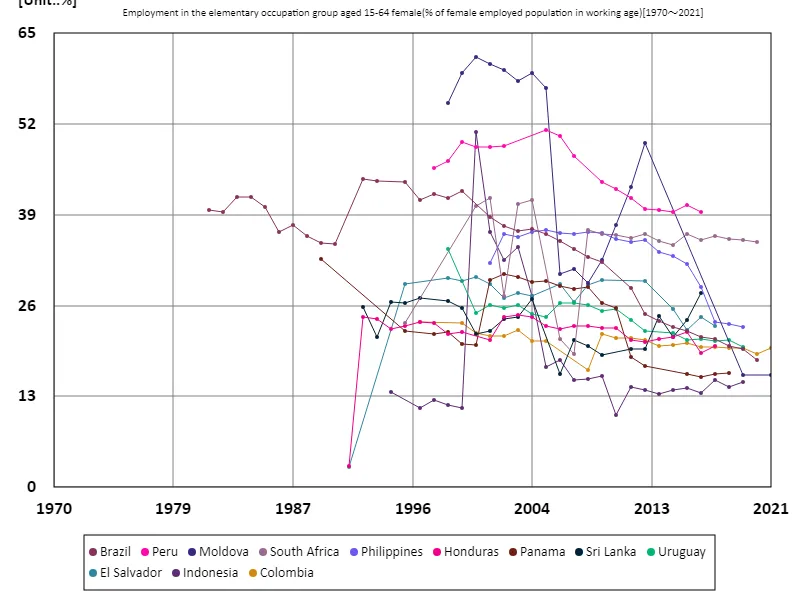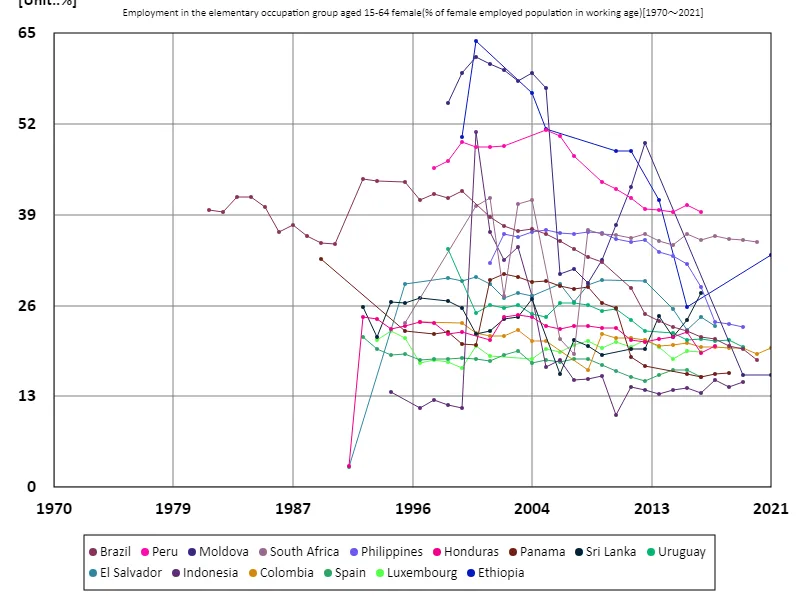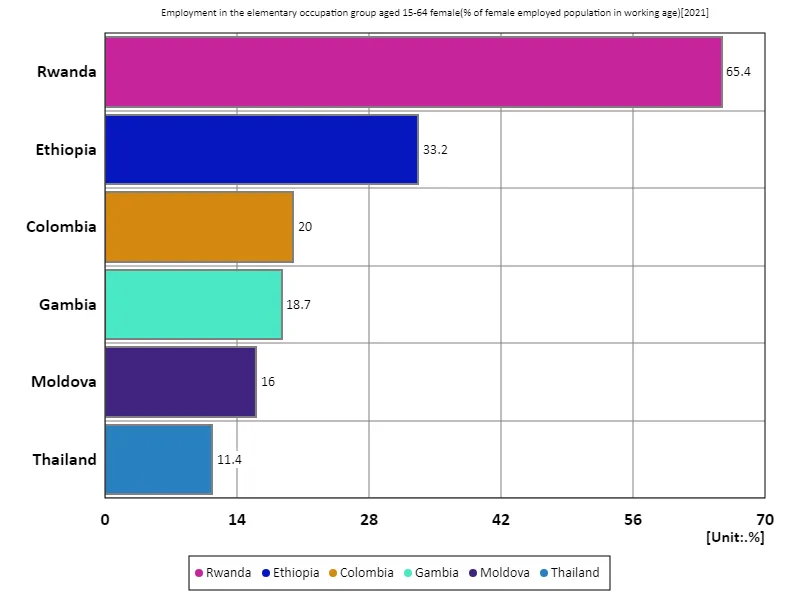- Abstract
- Employment rate for women aged 15-64 in the primary occupational sector (percentage of working-age female employment in the workforce)
- Employment rate of women aged 15-64 in the primary occupational sector (percentage of working-age female employment population) (Worldwide)
- Employment rate of women aged 15-64 in the primary occupational sector (percentage of working-age female employment in the labour force) (Worldwide, latest year)
- Reference
Abstract
Several factors are behind Colombia’s high employment rate in the primary occupational sector for women aged 15-64 in 2021, at 20%. First, the primary vocational sector has low levels of education and many women often work in this sector, especially in developing countries. In Colombia, many women enter primary occupations due to economic necessity and possibly also due to family and community expectations. In contrast, in developed countries, employment rates in the primary occupational sector tend to be lower due to the spread of education and diversification of the labor market. In countries like Colombia, expanding educational opportunities and labour market reforms may change primary vocational sector employment rates in the future, which will affect women’s economic status and social roles.
Employment rate for women aged 15-64 in the primary occupational sector (percentage of working-age female employment in the workforce)
Looking at data from 1981 to 2021, we see a notable change in employment rates in the primary occupational sector for women aged 15-64. In particular, Moldova recorded a peak of 61.6% in 2000, but has since fallen to 26%. This change is due to several factors. In Moldova, many women worked in the primary vocational sector during the period of economic transition following the collapse of the Soviet Union. However, as the economy and labor market transformation progress, they are now shifting to jobs requiring higher skills. In general, employment rates in the primary vocational sector tend to be higher in developing and economically challenged countries and lower in developed countries. This is because with the spread of education and economic development, people are moving towards more specialized occupations. Also contributing to this are the maturation of the economy and structural changes in the labor market. The example of Moldova shows that employment rates in the primary vocational sector can fluctuate widely due to economic changes and policy influences. Going forward, we expect to see a shift away from the primary employment sector due to diversification of the labour market and expansion of educational opportunities.


The maximum is 61.6%[2000] of Moldova, and the current value is about 26%
Employment rate of women aged 15-64 in the primary occupational sector (percentage of working-age female employment population) (Worldwide)
Data on primary occupational sector employment rates for women aged 15-64 from 1981 to 2021 reflects shifts in the global economy and changing social structures. In particular, Ethiopia recorded a high employment rate of 63.9% in 2000, but it has now fallen to 52%. This variation is due to several important factors. In Ethiopia, the high peak employment rate is due to a historical context in which primary occupations such as agriculture and handicrafts were predominant. Employment rates were likely high because many rural women were engaged in primary occupations. However, with recent economic development and urbanization, the number of better educated women has increased, and the labor market has changed. This change is driving a shift towards more specialized occupations. Additionally, government education policies and economic reforms are also having an impact. As education spreads, there is a shift away from the primary vocational sector and women’s labour market roles are also diversifying. This indicates that although employment rates in the primary vocational sector are declining, the breadth of women’s participation in the economy is expanding. In the future, further developments in these changes will likely bring greater clarity to women’s role in the labour market.


The maximum is 63.9%[2000] of Ethiopia, and the current value is about 52%
Employment rate of women aged 15-64 in the primary occupational sector (percentage of working-age female employment in the labour force) (Worldwide, latest year)
Data for 2021 shows that Rwanda recorded the highest employment rate in the primary vocational sector among women aged 15-64 at 65.4%, compared to an average of 27.5% and a total of 165%. Several important trends emerge from this data. First, Rwanda’s high employment rate reflects the fact that it is primarily primary occupations such as agriculture and crafts, and that women are overrepresented in these sectors. In developing countries like Rwanda, women tend to be more likely to be in the primary vocational sector due to limited access to education and skills. In contrast, economically advanced countries have a rise in more specialized occupations and a lower employment rate in the primary occupational sector. Additionally, the figure ”total 165%” suggests that some women may be engaged in more than one primary occupation. Especially in rural areas, it is common for people to work multiple jobs to support their families. This is likely due to economic necessity and the structure of the local community. Overall, employment rates in the primary vocational sector depend strongly on a country’s stage of economic development, the level of educational attainment and the structure of its labour market. In the future, as education improves and the economy becomes more diverse, these employment rates are expected to change and people will move towards more diverse occupations.


The maximum is 65.4% of Rwanda, the average is 27.5%, and the total is 165%



Comments